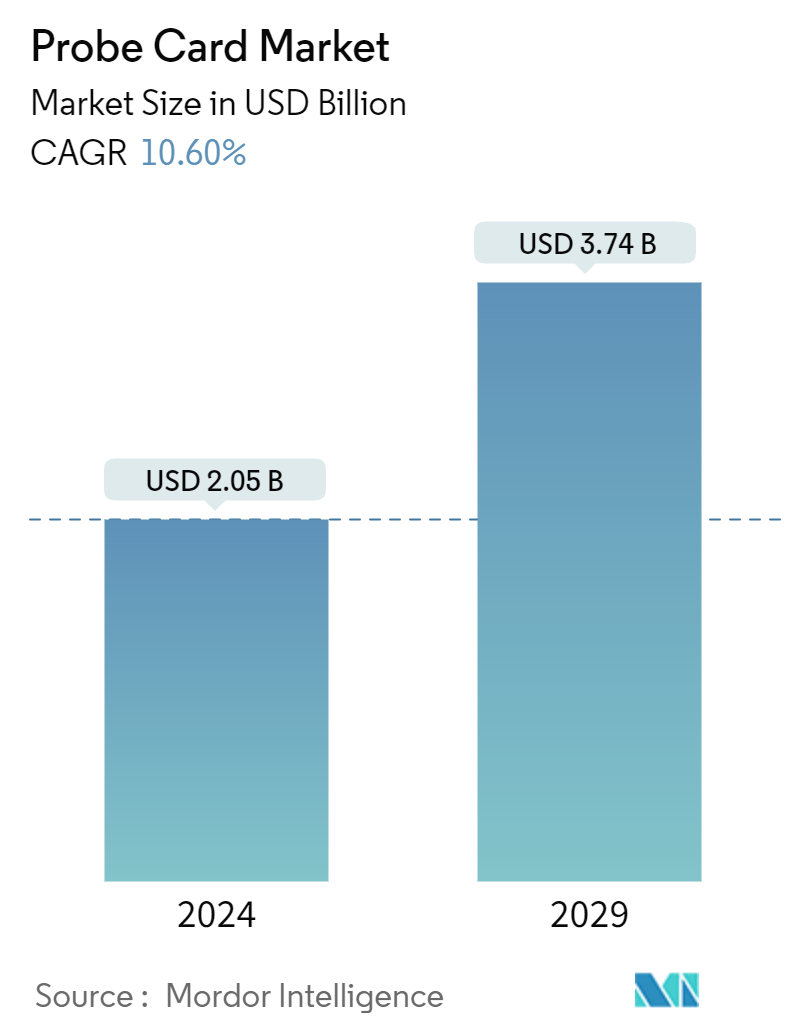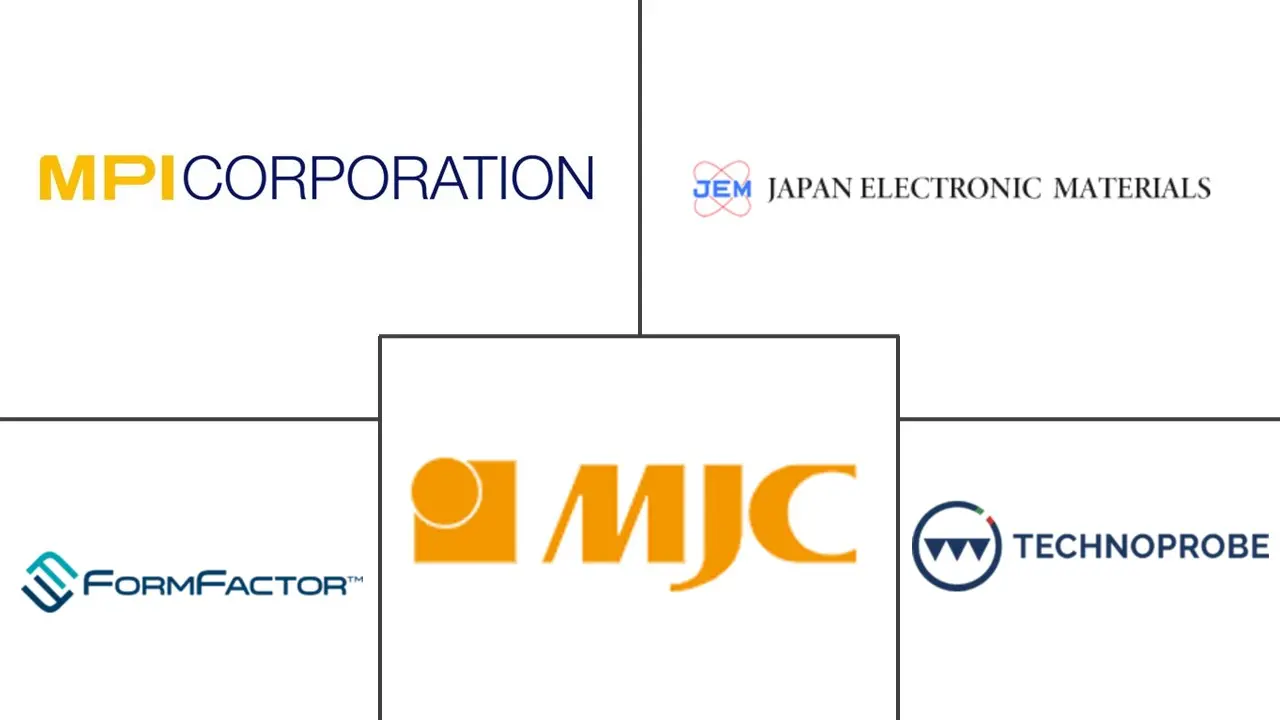Market Size of Probe Card Industry

| Study Period | 2019 - 2029 |
| Market Size (2024) | USD 2.05 Billion |
| Market Size (2029) | USD 3.74 Billion |
| CAGR (2024 - 2029) | 10.60 % |
| Fastest Growing Market | Asia Pacific |
| Largest Market | Asia Pacific |
| Market Concentration | Medium |
Major Players
*Disclaimer: Major Players sorted in no particular order |
Probe Card Market Analysis
The Probe Card Market size is estimated at USD 2.05 billion in 2024, and is expected to reach USD 3.74 billion by 2029, growing at a CAGR of 10.60% during the forecast period (2024-2029).
- Increased semiconductor production and continuous government and key vendor investment in establishing semiconductor foundries are driving the growth of the market.
- The advancement in packaging technology further boosts the demand for highly efficient probe cards to test semiconductor chips. MEMS technology gained traction in the probe card market due to the benefits and accuracy it offers during testing. The augmented use of semiconductor chips in several industry verticals, including automotive, communication, consumer electronics, and healthcare, is also increasing the growth of the market.
- However, the high cost associated with the probe cards restricts the growth of the market. An increase in the prices of raw materials enhances the production cost of probe cards, which, in turn, restricts the growth of the market.
- The increased demand for semiconductor memory chips, mainly DRAM and Foundry and Logic ICs, across consumer electronics, automotive and robotics, and other applications creates a huge demand for probe cards to test the chips' functionality. Due to growing consumer demand, exponential growth in semiconductor manufacturing drives the DRAM, foundry, and logic IC market.
- The high cost associated with probe cards presents multiple challenges that are restricting the growth of the market. Significant initial investment requirements, increased production and maintenance costs, reduced scalability and flexibility, slower adoption of new technologies, and barriers to entry for smaller players are some of the factors that result in higher costs for probe cards.
- The ongoing trade tensions between China and the United States have significantly impacted the growth of the memory market. From a Chinese standpoint, the commercial restrictions imposed by the US Department of Commerce in October 2022 created uncertainty regarding the expansion of memory production. As a result, the combined wafer capacities of the top memory companies, YMTC and CXMT, are expected to be limited to approximately 180kWpm over the next five years.
Probe Card Industry Segmentation
A probe card is used in the electrical testing of a wafer's large-scale integrated (LSI) circuit chip during the wafer test phase in LSI manufacturing. It is connected to a wafer probe, enabling the connection of the LSI chip electrodes, while an LSI tester functions as the measuring device. The probe card's needles establish contact with the LSI chip electrodes to conduct electrical testing for the go/no-go test.
The probe card market is segmented by technology (MEMS, vertical, cantilever, specialty, other technologies), by application (DRAM, flash, foundry and logic, parametric, other applications), by type (standard probe card, advanced probe card), by geography (North America, Europe, Asia Pacific, Rest of the World). The market sizes and forecasts are provided in terms of value (USD) for all the above segments.
| By Technology | |
| MEMS | |
| Vertical | |
| Cantilever | |
| Speciality | |
| Other Technologies |
| By Application | |
| DRAM | |
| Flash | |
| Foundry and Logic | |
| Parametric | |
| Other Applications |
| By Type | |
| Standard Probe Card | |
| Advanced Probe Card |
| By Geography*** | |
| North America | |
| Europe | |
| Asia | |
| Australia and New Zealand | |
| Latin America | |
| Middle East and Africa |
Probe Card Market Size Summary
The probe card market is poised for significant growth, driven by the increasing demand for semiconductor chips across various industries such as automotive, communication, consumer electronics, and healthcare. This demand is further fueled by advancements in semiconductor packaging technology and the rising adoption of MEMS technology, which offers enhanced accuracy and efficiency in testing semiconductor devices. The market is characterized by a high level of fragmentation, with numerous global players and SMEs competing for market share. Key players are actively engaging in strategic partnerships and acquisitions to strengthen their product offerings and maintain a competitive edge. However, the market faces challenges due to the high costs associated with probe cards, which are exacerbated by rising raw material prices and significant initial investment requirements.
Regionally, Asia-Pacific is expected to remain a dominant force in the probe card market, supported by its robust semiconductor manufacturing base and increasing integration of semiconductors in automotive electronics. Countries like China, Japan, and South Korea are at the forefront, with substantial investments in automotive and semiconductor industries driving demand for probe cards. The ongoing development of electric vehicles and the expansion of 5G infrastructure in China further contribute to market growth. Despite challenges such as trade tensions impacting memory production, the market's expansion is supported by the growing need for advanced testing solutions in semiconductor manufacturing, particularly in the automotive and consumer electronics sectors.
Probe Card Market Size - Table of Contents
-
1. MARKET INSIGHTS
-
1.1 Market Overview
-
1.2 Impact of COVID-19 Aftereffects and Other Macroeconomic Factors on the Market
-
1.3 Industry Attractiveness - Porter's Five Forces Analysis
-
1.3.1 Bargaining Power of Suppliers
-
1.3.2 Bargaining Power of Buyers
-
1.3.3 Threat of New Entrants
-
1.3.4 Threat of Substitutes
-
1.3.5 Intensity of Competitive Rivalry
-
-
1.4 Technology Snapshot
-
1.5 Pricing Trend Analysis
-
-
2. MARKET SEGMENTATION
-
2.1 By Technology
-
2.1.1 MEMS
-
2.1.2 Vertical
-
2.1.3 Cantilever
-
2.1.4 Speciality
-
2.1.5 Other Technologies
-
-
2.2 By Application
-
2.2.1 DRAM
-
2.2.2 Flash
-
2.2.3 Foundry and Logic
-
2.2.4 Parametric
-
2.2.5 Other Applications
-
-
2.3 By Type
-
2.3.1 Standard Probe Card
-
2.3.2 Advanced Probe Card
-
-
2.4 By Geography***
-
2.4.1 North America
-
2.4.2 Europe
-
2.4.3 Asia
-
2.4.4 Australia and New Zealand
-
2.4.5 Latin America
-
2.4.6 Middle East and Africa
-
-
Probe Card Market Size FAQs
How big is the Probe Card Market?
The Probe Card Market size is expected to reach USD 2.05 billion in 2024 and grow at a CAGR of 10.60% to reach USD 3.74 billion by 2029.
What is the current Probe Card Market size?
In 2024, the Probe Card Market size is expected to reach USD 2.05 billion.

